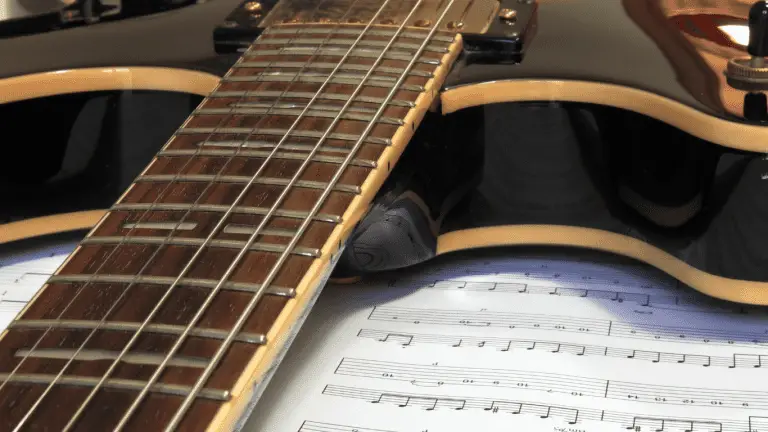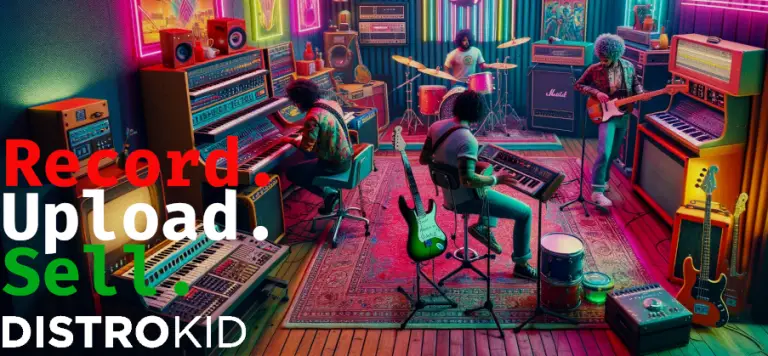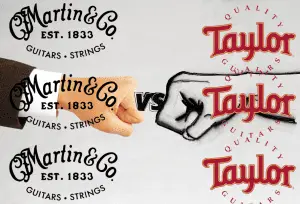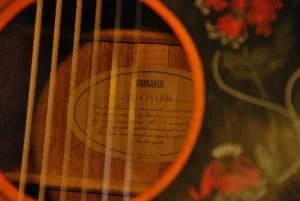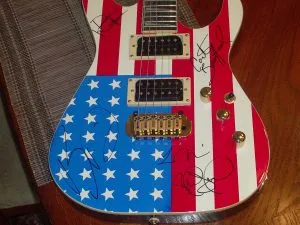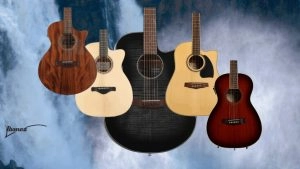One of the topics that newcomers most often ask guitar tutors about is the CAGED system. The term seems confusing, and it can be challenging to get a clear answer online as it’s steeped in musical theory. However, strangely, many beginners who have been playing for a few months or even up to a year are already using CAGED without realizing it.
In the simplest terms, the CAGED system is a way to understand the layout of your fretboard, then use that knowledge to improve your playing. Let’s help you dive into the CAGED method!
What Is The CAGED System For Guitar?
Like the piano, a guitar’s notes follow a logical progression in a grid-like fashion. But the guitar’s layout doesn’t follow the same structure as a piano, which is why many new guitar players get confused. The note you get will depend on the position on the fretboard where you play a particular string, and despite how confusing it may seem, there is a pattern to it.
The CAGED method lets you quickly memorize and picture this layout of notes on the entire fretboard. When you know which note to play where on your guitar’s neck, there’s no limit to what you can play. That’s why many of the greatest guitarists in the world use CAGED, whether they realize it or not.
What Does The CAGED Acronym Stand For?
CAGED is an acronym for the five open chord shapes you can use to play any chord. Those shapes are:
The C shape
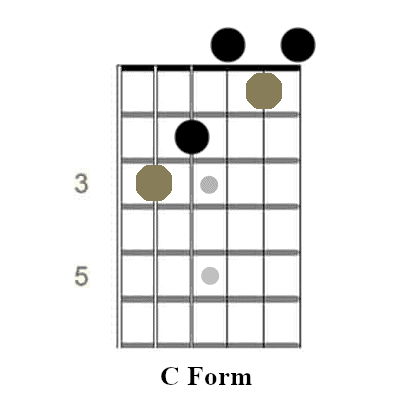
The A shape
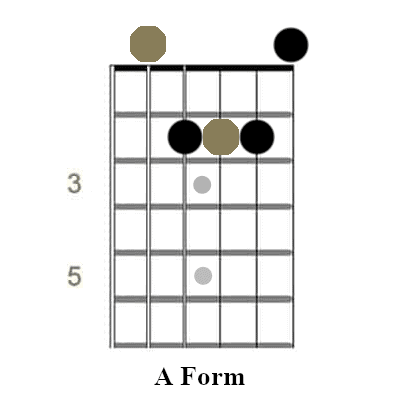
The G shape
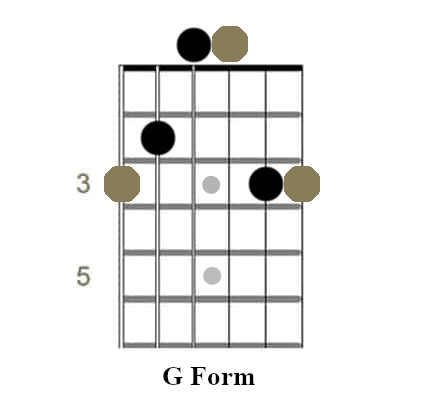
The E shape
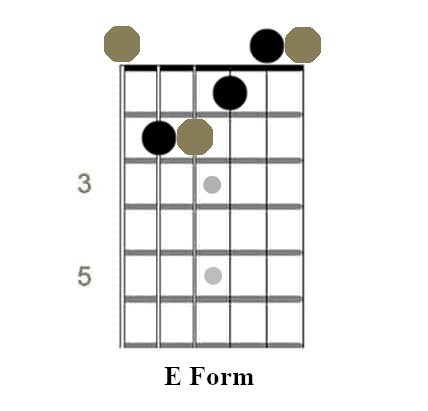
The D shape
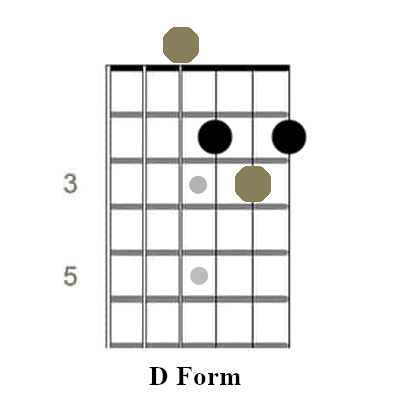
When you understand CAGED and know how to play these five major chord shapes, you can play any major chord of your choice anywhere on the neck of the guitar.
The Five CAGED Chords And How They Work
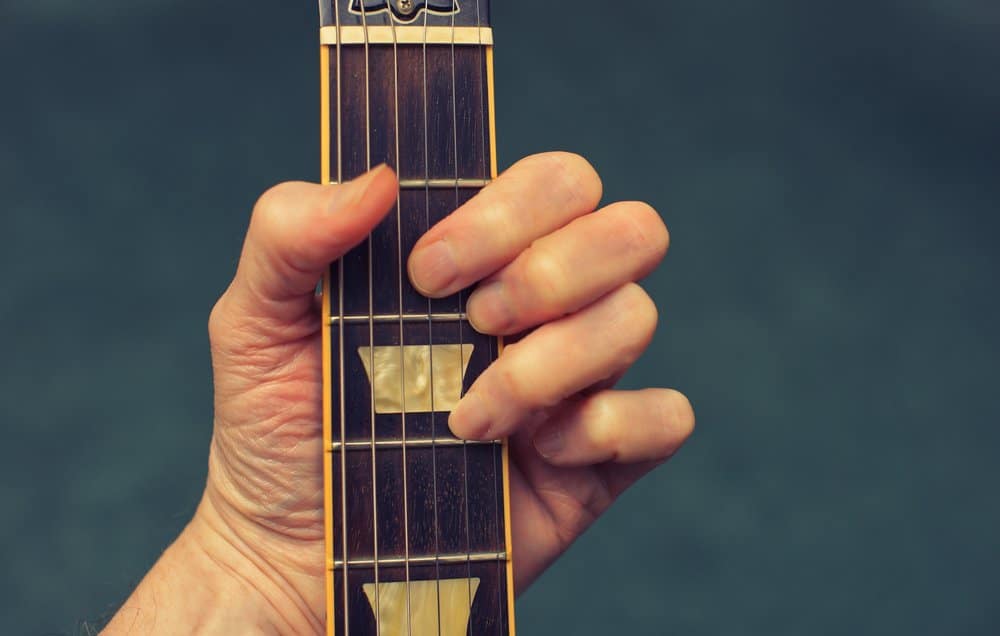
The CAGED chord system is based on the five open chords. For example, pressing the E open chord shape and moving your hand up the guitar’s neck will let you play different chords using the same shape.
If this sounds familiar, there’s a good reason: barre chords and power chords both use the CAGED principle and are the most common applications of CAGED in actual playing.
With barre chords, you simply press your open chord of choice (the A and E major are the most popular). As you move the shape up the fretboard, you barre the first fret of the chord with your index finger to simulate the guitar’s nut and change the notes that the strings will play in that position.
The Five CAGED Major Open Chord Shapes Up The Neck

To see how the CAGED chord system works, let’s visualize how the chords change as you move each of the standard open chords up on the neck:
The C Major Open Chord Shape
When you press an open C chord and move it up four frets, you will play an E major. However, you must barre the fourth fret to get the right chord.
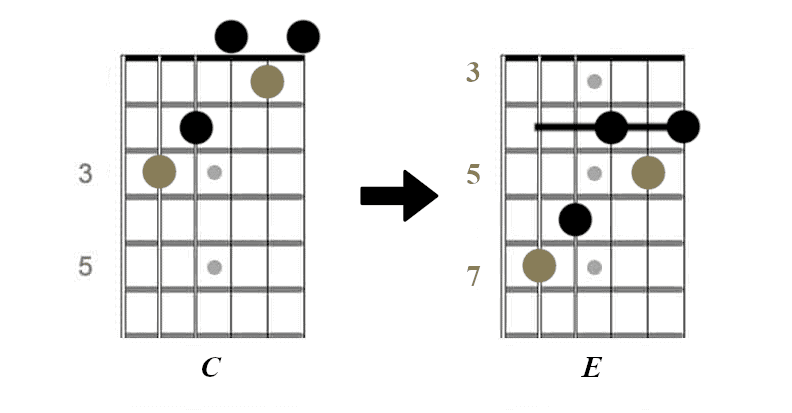
The A Major Open Chord Shape
The A chord shape is one of the two most popular chords to use in this way. If you press a standard A open chord, move the shape up five frets, and barre the fifth, you will play a D chord.
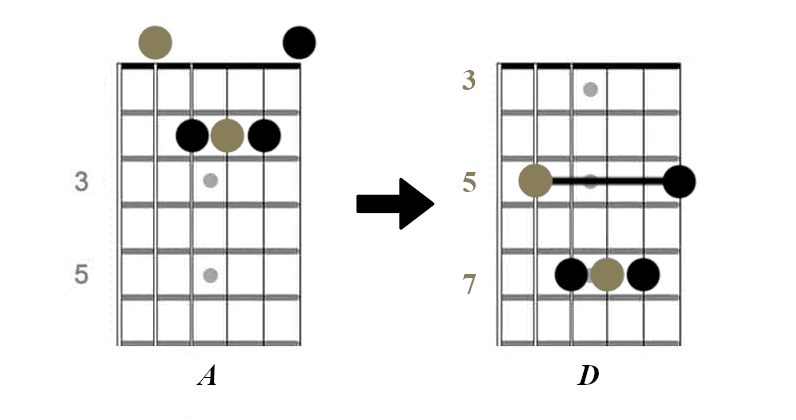
The G Major Open Chord Shape
Playing an open G chord and moving it up five frets will play a C chord. However, because you have to barre the fifth fret, it’s challenging to use the G chord shape this way. That’s why it’s not one of the popular CAGED open shapes.
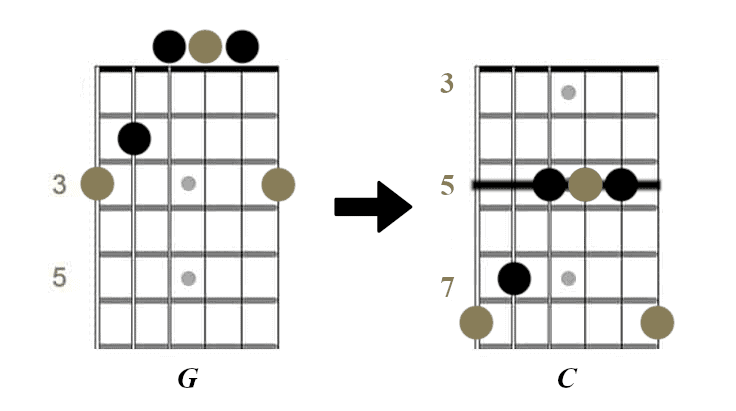
The E Major Open Chord Shape
Positioning your hand to play an E major chord and moving it up five frets, barring the fifth, will play a major A chord. The E major open shape is perhaps the most popular chord in the CAGED method.
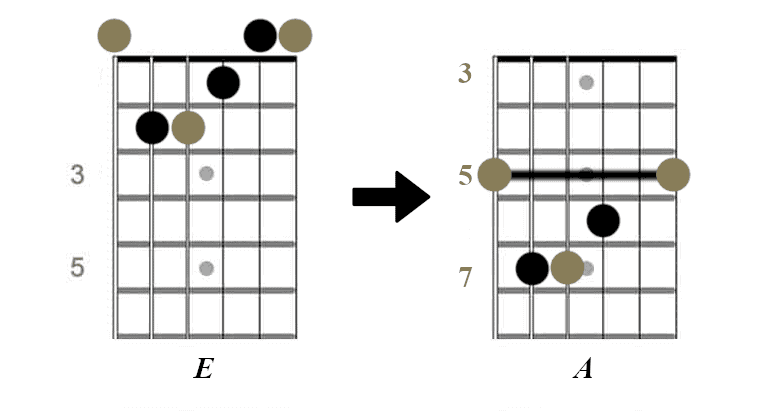
The D Major Open Chord Shape
Playing the D major open chord shape five frets higher on the neck will give you a G major chord, again while barring the fifth fret with your index finger.
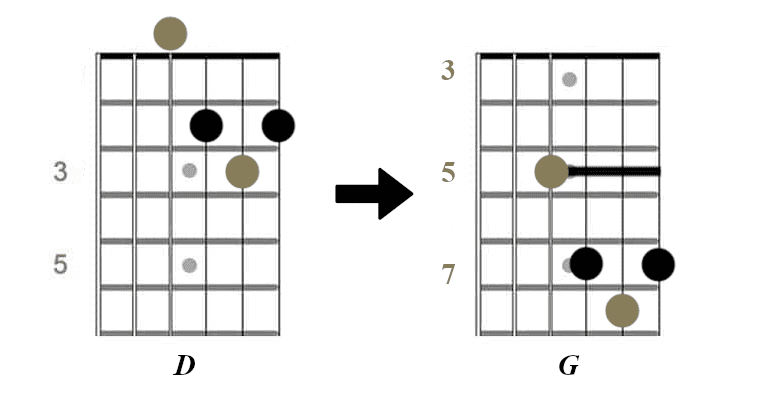
How The CAGED Major Chords Connect
In CAGED, all major shapes are connected in a pattern that repeats across the entire fretboard:
- The C shape connects with the A shape
- The A shape connects with the G shape
- The G shape connects with the E shape
- The E shape connects with the D shape
- The D shape connects back with the C shape
This loop then repeats, regardless of where you finish the sequence on the fretboard.

How The CAGED Framework Helps You Visualize The Major Scale
The primary benefit of the CAGED method is that it helps you better understand and visualize the major scale. But how does this work?
Pretty simple. Using CAGED, you can easily visualize where the root of the scale is located all over the fretboard. You will then build each one of the scale’s positions around these root notes. And because you will already have memorized the key intervals of each open shape (major third, fifth, and octave), you will only have to learn a few more notes to visualize each major scale position around the CAGED shapes.
Read our major scale article to understand this in detail.
CAGED Major Chord Variations
The CAGED chord system works with every major scale variation, including 7th chords and arpeggios.
CAGED Major 7th Chords
Just as you would with the standard C, A, G, E, or D open shapes in CAGED, you can press the open Major 7th equivalent of any shape. As you move the 7th shape up the fretboard, you will get different Major 7th chords.
Check out this video by Ry Naylor on how to visualize 7th chords using CAGED:
CAGED, Arpeggios, And Solos
CAGED is also of great help for playing arpeggios. Understanding the CAGED arpeggios will also help you to play solos on the major scale.
Guitar Songs With CAGED Chords
The are many famous and popular songs that use CAGED chords. Here are some of my favorites:
“Listen to the Music” by The Doobie Brothers
“Old Love” by Eric Clapton
“Shooting Star” by Bad Company
“It Ain’t Over ‘Til It’s Over” by Lenny Kravitz
The CAGED System Explained On YouTube
There’s a wealth of information on YouTube that can help you better understand the CAGED chord system. Some of my favorites are:
The CAGED Method In Under 10 Minutes
The Art of Guitar made this video for one simple reason: most YouTube videos about the CAGED method were too complicated and steeped in musical theory. This video is one of the most straightforward explanations of CAGED anywhere, and it’s like a video on the CAGED system for dummies.
How To Use CAGED To Play A Solo
CAGED isn’t only for chords. This video is excellent because Scott Paul Johnson explains the easiest way to use CAGED to play impromptu solos in a way anyone can follow.
How to Apply the CAGED Method
Guitarists who already understand CAGED but want to know how to apply it in their playing will find this video helpful. Sam Blakelock is a master instructor who conveys the different dynamic ways you can use CAGED in your playing.
The CAGED Minor System
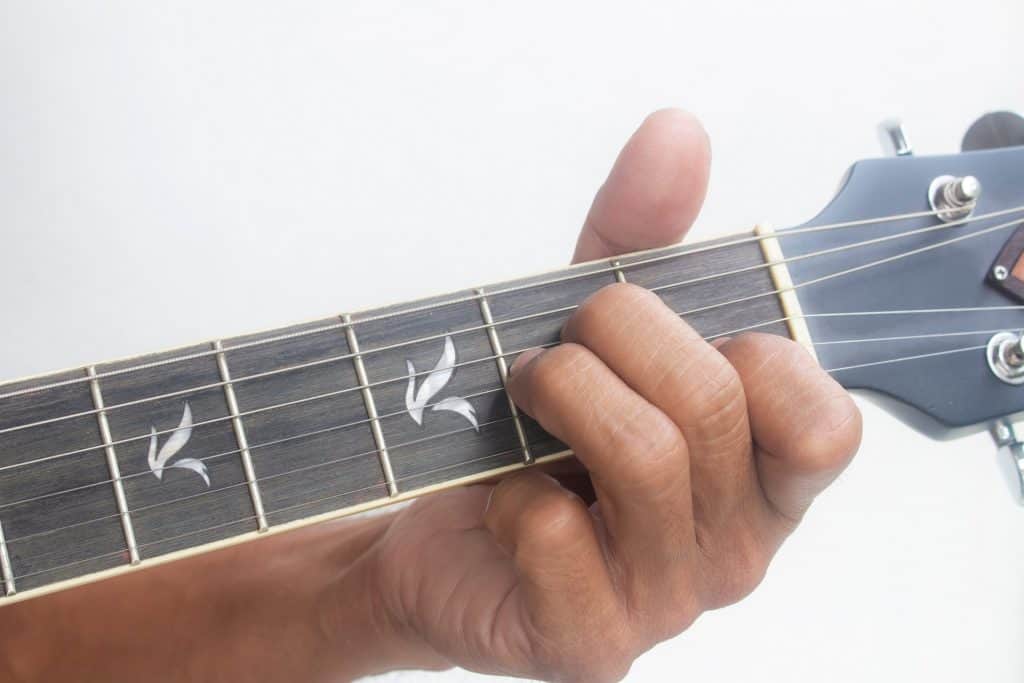
Interestingly, CAGED isn’t limited to major chords. You can play minor chords similarly, using the Cm, Am, Gm, Em, and Dm open chord shapes, making CAGED even more dynamic and powerful.
Check out our article on the CAGED minor system to see how this works.
How To Learn And Memorize The CAGED System
The first step to learning the CAGED method is understanding what it is and what it does. But after that, you need to know how to use it. There are two simple steps to this process.
- Memorize Each One Of The CAGED Shape
Make sure you understand each shape thoroughly. Move it up and down the fretboard, and figure out which chord you are playing each time.
- Memorize How Each CAGED Shape Connects To Each Other
Once you know each shape by heart, make sure you know how they are interlinked. Refer to the previous section of this article, where we explain how the CAGED shapes connect.
Also, download this helpful CAGED system PDF as a visual cheatsheet to aid your memory.

CAGED System Exercises
The next step is to practice and keep practicing. The more CAGED method exercises you do, the more your skills will improve. Many of these exercises have to do with barre chords, which can be challenging to get used to, but if you keep up with them, you will eventually master them.
Here are a couple of my favs on YouTube:
Over 40 and Still Don’t Know C.A.G.E.D? (DO THIS!)
Andrew Wasson used a great, clickbaity title for this video. But it’s useful for guitarists of all ages!
He explains a few basic exercises for learning the mapping of the root notes of the CAGED system all over the fretboard—a great way to build a solid CAGED foundation.
The Truth About the CAGED System
Here Paul Davids does an excellent job explaining the CAGED system overall. But my favorite part starts at 13:29, where he shows an example of a chord progression using the CAGED method. It qualifies as a beautiful exercise to learn to use the system in practice.
FAQ
Although the CAGED method isn’t challenging to learn, it can be complex to understand, especially for those who don’t want to spend hours learning musical theory. Here are some of the questions most people ask about CAGED.

Is The CAGED System For Beginners?
The CAGED framework uses five of the first open chords that beginner guitarists learn. Furthermore, it teaches beginners essential skills and a proper understanding of their fretboard, which will improve their guitar-playing abilities. So, with that in mind, the CAGED system is perfect for beginners.
Is The CAGED System The Major Scale?
The major scale is a scale that consists of seven notes separated by step and half-step intervals in a repeating pattern. CAGED helps note and remember where these notes and their repeating patterns are located on a guitar’s fretboard. The two concepts aren’t the same thing, but they are linked. CAGED theory is just that: theory.
You can think of the scale as the road you must take to a destination with physical locations. The CAGED framework would be the roadmap that guides you along this road.
Why Are B And F Not Included In CAGED?

B and F are not included in the CAGED methodology because there is no way to play them as open chords on the guitar. But if you understand the CAGED framework, you can play B, F, or any other chord using any of the CAGED shapes all along the fretboard.
How Do You Improvise With The CAGED System?
As mentioned in the section about arpeggios and playing solos, CAGED helps you understand where particular notes are located on the fretboard and which scale shapes you can use to play them.
Did Jerry Garcia Use The CAGED System?
People often credit Jerry Garcia of the Grateful Dead for having invented the CAGED method. Most of his solos were improvised using the open chord positions, as illustrated in CAGED. Here is a good example on YouTube:
Does CAGED Work For Minor Chords?
You can use the CAGED framework for minor chords by using the Cm, Am, Gm, Em, and Dm open shapes across the fretboard as you would with the majors.
Is The Guitar CAGED System Good Or Bad?

The CAGED system is just a way to learn how the fretboard is mapped. On the positive side, it’s an easy method and teaches you horizontal scale patterns, which many other systems don’t.
On the negative side, how most people learn CAGED can lead to decreased playing speed. CAGED mostly deals with horizontal scale patterns, which does lead to slower playing if it’s all you know. The crucial point is that CAGED isn’t the alpha and omega of good guitar playing. Learn different techniques rather than focusing on CAGED alone.
Is There A Good CAGED System App Out There?
There are two excellent apps for learning CAGED. On Android, the best option is FretBuzz CAGED System. On iOS, you should go for David Mead: CAGED.
What Is The Best CAGED System Book You Recommend?

There are two excellent books focused on the CAGED framework. The first is The CAGED System for Guitar: A Clear-Cut Guide To Learning The Entire Fretboard by Pete Madsen. It deals with the CAGED method in general.
The second book I recommend is The CAGED System for Guitar: A Fretboard Mastery Method for Lead and Solo Guitarists by James Shipway. It is for those who want to focus on lead and solo playing.
What Key Is CAGED In?
The answer is simple: all of the keys! CAGED is not a note, chord, scale, or song. It is a method to learn where to play particular notes on the fretboard, which will always be the same regardless of which key you’re playing.
After The CAGED System, What Do You Recommend As The Next Step?

Knowing the CAGED framework is just the beginning. Your next step should be learning how to apply it musically, often combined with some special techniques like triads and inversions. Don’t worry; those are not as complicated as they sound, and after learning the CAGED system, it will all come more naturally for you.

